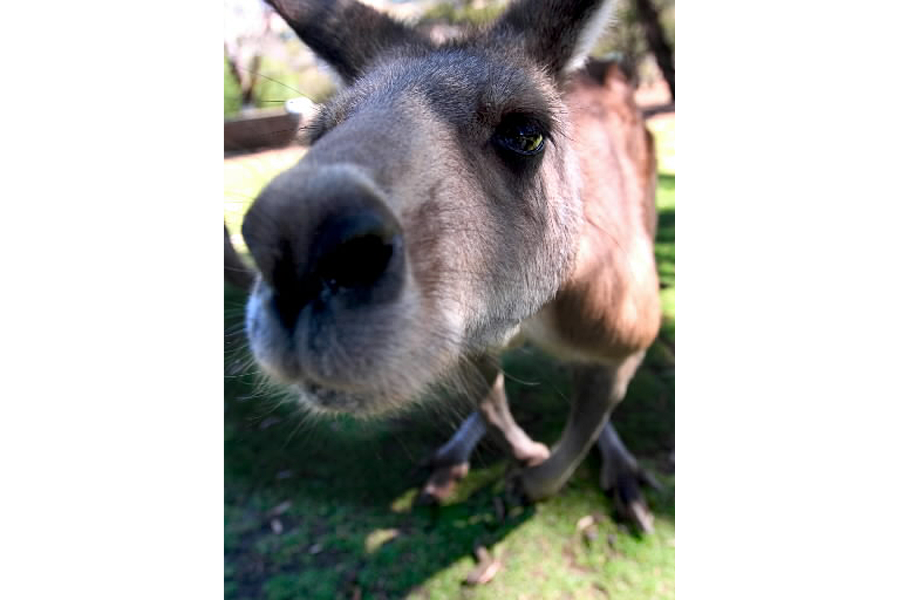How gassy are kangaroos actually?
Loading...
Several years ago, scientists proposed a novel solution to curb global warming: eat kangaroos.
The reasoning goes like this: By replacing cattle, who tend to produce large amounts of methane – mostly by means of belching, but also out the back end – with kangaroos, who, thanks to their physiology, are thought to be less gassy, we can reduce the amount of planet-heating emissions caused by our meat consumption.
But the kangaroo, it turns out, might not be the low-emission marsupial that we all thought.
Cows and sheep may top the greenhouse gasses produced by Australia's iconic marsupial, but kangaroo emissions might not be very special, zoologist Adam Munn and colleagues write in a new paper published Wednesday in the Journal of Experimental Biology.
"Kangaroos are low-methane, but they're not any lower than other herbivores that are non-ruminant, like horses," Dr. Munn tells The Christian Science Monitor in an interview.
Where did scientists get the idea that kangaroos were low-methane? It turns out they were looking at the wrong end.
"With kangaroos, most of the methane comes out the back end, not the front end like you're used to seeing in sheep and cattle," says Munn. By focusing on the marsupial's belches, Munn says, some previous researchers were missing the gas.
Methane gas is a potent one. Livestock contributes about 14.5 percent of all greenhouse gas emissions globally, according to the Food and Agriculture Organization of the United Nations. And methane makes up 44 percent of those gases.
About 39 percent of livestock's greenhouse gas emissions globally are from ruminants' fermentation digestive processes. So when scientists heard that kangaroos might not release any, or at least very little, methane, they started searching for ways to harness that ability for the meat industry.
One thought was that unique microbes in the kangaroos' guts broke down their meals without producing as much methane gas. But Munn isn't so sure.
"There’s some question about whether or not it’s possible to use the microbial population from the gut of kangaroos and if they could be transplanted into sheep and cattle to try and reduce the methane emissions from those animals," he says. But that community of microbes might not help. Munn and his colleagues think the lower methane emissions of kangaroos may have more to do with the way they digest food.
In ruminants like cows and sheep, the food first travels into the rumen, which Munn describes as a big vat. There, the animal's meal goes through a long digestive process that includes a great amount of microbial fermentation. "Food doesn’t leave that big vat until it’s really broken down to fine particle sizes," says Munn. Then, "the fluids and particles all move through the gut at the same pace in a sheep or a cow."
But that doesn't seem to be the case in kangaroos. In the marsupials, the particles are held in the foregut while the fluids are pushed on. This faster process, Munn says, likely means the microbes cannot move on to their adult stage quite as readily.
"It’s like the environment in the kangaroos’ fore-stomach is almost like a new environment every time, whereas in something like a sheep or a cow, it's like a really well established forest," Munn explains.
The researchers propose this explanation based on the way a kangaroo's methane emissions varied in response to different portion sizes.
To study this, individual kangaroos were isolated in chambers that had an inflow and an outflow of air that were carefully tested and monitored. The researchers gave the 'roos two different size meals. In one scenario, the food was unlimited, while in the other it was rationed. They found that when the kangaroos had less food, they produced more methane.
The researchers think this shift has to do with how quickly the fluids from the kangaroo's meal was pushed on, out of the foregut. As more food is packed into the gut, more liquid is forced out, leaving less time for the microbes to mature and produce methane.
So, Munn says that scientists' efforts to isolate kangaroo gut microbes to improve ruminants' eco-friendliness might be misguided. "It’s not about the type or the species of microbe, if you like, it's about the environment that the microbes are living in," he says.
Four species of kangaroo in Australia are already used for meat and leather. Two of those, the western grey kangaroo and red kangaroo, were the subjects of this study.
"The idea of replacing some red meat intake with kangaroos is not a bad idea," Munn says. "It's a viable alternative food source."
But it's not just about meat. In Australia, the rangelands that farmers would fill with kangaroos in this scenario are not just used for meat animals currently. Some are filled with merino sheep bred for their wool. "So, it's not a direct comparison," Munn says. "You can't necessarily swap them over like that. One is a textile, one is a meat."






